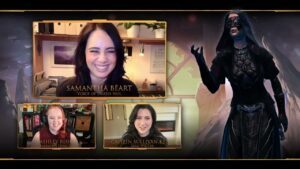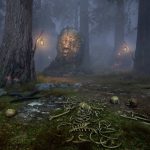I’m a stranger in a strange land. The people’s faces are familiar, but their names and customs are alien. In Eorzea, the masses gather in the streets and cheer for me, for I am Nidhogg’s bane, Ala Mhigo’s liberator, a knight of House Fortemps, and the Warrior of Light. However, those titles mean nothing in Final Fantasy XIV’s newest world, Norvrandt. I’m no one here. Nothing. Hell, if the locals knew I was a champion of the light, they would grab the closest pitchfork and mount my head on a stick. Norvrandt isn’t Eorzea, and as the light fades from my heart and a sunless sea of night seeps in, some emboldening words from my precursor, Ardbert, help me gain balance: “not even the most valiant heroes can stand alone” – the Warrior of Darkness has come.
That’s how my journey through Final Fantasy XIV: Shadowbringers felt. Square Enix’s MMORPG catastrophe-turned-remarkable-comeback-story is on the eve of the sixth anniversary of its revival, and I couldn’t dream up a better way to commemorate the occasion than with what this new expansion brings to the table. It’s bloody brilliant, and the most fun I’ve ever had with Final Fantasy XIV.

The story dug its hooks in me from the get-go. A voice beckons from across the void; the same that courted your companions, the Scions of the Seventh Dawn, and rendered them catatonic. That voice belongs to the Crystal Exarch, the self-appointed guardian of a world called Norvrandt (“The First” to the celestial-inclined), and he, like his world, require your god-slaying talents because all their own heroes are long dead. Malevolent light ravages this land as an unchecked blight, darkness is but a memory, and it’s up you to restore balance to the firmament. The Exarch also admits he kind of, sort of, totally-not-on-purpose dragged the spirits of your fellow Scions to Norvrandt and gave them corporeal form here too. So, you know, you should probably reunite with them and chew the fat while also saving the realm.
Light and darkness as a motif for good and evil is hardly a new idea, even just within Final Fantasy, but it’s how Shadowbringers challenges those tropes that make its story extraordinary to me. Instead of representing the side of good, this light is an abhorrent miasma of death and disease shepherded by the Sin Eaters, malevolent beings that want to imbue Norvrandt in a twisted radiance. You’re here to blow out the candles.
We Shall Stay The Flood
The islands of Kholusia is where my journey began, and it’s also where I bore witness to the geopolitical ramifications of the encroaching light firsthand. People were clamoring to enter Eulmore, the City of Final Pleasures, and wanted my help to get in. Eulmore is a decadent house of debauchery, and the oppressed only gain entry through a showcase of artistic talent. A songstress pleads I accompany her to the wilds so she can practice singing in peace, too bad her high-notes tend to draw the attention of Sin Eaters. She sang, and sure enough, I had to bust heads. This would otherwise be a straightforward mission to complete, but the writing humanizes the typical MMORPG go-here-and-kill-seven-boars manner of quests, and mundane tasks are suddenly made captivating.

The rest of the zones in Shadowbringers are all just as tragic as Kholusia. Beautiful on the surface with a horror story waiting to be uncovered just beneath. In Amh Araeng, I found a makeshift encampment for those exposed to Sin Eater magic. It’s a slow, grizzly end for these people, so the caregivers cook them a final meal laced with poison. Better to go quietly in your sleep, I suppose. One of the caregivers, Tesleen, recites a nursery rhyme as I comfort the sick; “Warrior of Darkness, servant of death, take care of our souls at our dying breath. Let sinners and eaters of sin go with thee, that all may return to the sunless sea.” Norvrandt’s end is nigh unless I course-correct fate, and quickly.
“
I paused, then cocked a brow before undertaking the first Role Quest, Shadowbringers’ progression supplement for job-specific quests. I’m just so accustomed to begrudgingly trudging all the way back to Gridania to learn a new skill every few levels. But instead, here in Norvrandt, Role Quests are divvied up depending what part you play, which is a welcome change. As a White Mage, I went with the healer Role Quests, and that’s where I partnered with Giott; a dwarven warrior whose soft, luscious bread smelt of freshly tapped ale.
If Giott wasn’t busy pounding-back a fourth (or fifth) round of booze, we’d be off hunting Sin Eaters. That’s when the history lessons started. I learned of the exploits, triumphs, and failures of Norvrandt’s heroes that came before, and how their misactions ultimately led to the current state of the world; the hook was great on its own, and you even get to take part in these tales in the form of playable flashbacks. The one-two punch of main scenario quest pertinence, while also fleshing out the world’s backstory made Role Quests more compelling to me than Job Quests have ever been. Perhaps they lack in practicality a smidge since they do not disperse new abilities like job quests, but that’s fair trade in my eyes. I’d much rather listen to Giott go on about their favorite greasy spoon anyway.
With a new world comes new peoples and cultures, and Shadowbringers welcomes two new playable races to the fold: The Viera, scantily clad, long-limbed humanoid hares of Final Fantasy XII fame; and the Hrothgar, burly lion-men that take their looks after the Ronso from Final Fantasy X. It’s popular among the community to drink a Fantasia Potion and take on the look of either as of late, but I’m too attached to my Miqo’te to join in. Still, the Viera and Hrothgar fit right in with all the cat-girls, elves, and buff, seafaring folk of Final Fantasy XIV; we’re a colorful lot, I admit. It’s a shame that both are host to gender-locking though, as the Viera can only be female, and conversely, the Hrothgar can only be male. Hopefully, one day, I can invite sultry bunny-men and fierce lionesses alike to my party.
When the time came for the curtain call on the main scenario quest, which took nearly 80 hours of play, I was ready to stand and applaud. Storylines that have been building since A Realm Reborn are wrapped up with such grace that I have to wonder how long the writers have had their cards close to the chest. Old friends, like Thancred, are given room reflect on their past misgivings and grow as characters. While fresh faces, like my ethereal companion, Ardbert, really stole the show, as he reminded me that the quiet after the storm should be just as cherished as the thrill of adventure. It helps that the dialogue is razor sharp and the voice acting is better than ever. Shadowbringers is my favorite storyline to be penned into a Final Fantasy game in nearly two decades. A tale of how darkness should not blindly bend the knee to light, for there is just as much beauty in a sea of stars as there is in a sunrise.
Let Us Be About It, Hero
Not to make (ahem) light of a grim situation, but I enjoyed leveling in Shadowbringers more than any progression crawl in Final Fantasy XIV; most notably the dungeons and trials. Holminster Switch, the first four-person dungeon, is a grim scene. The forest is burning, and animals twist into luminescent horrors while villagers barrel past me, trying to escape the carnage. Philia, the dungeon’s final boss, is the perfect introduction for what to expect from group content in the expansion. Dodge, circle when necessary, and watch the boss’s body language rather than rely solely on damage indicators to tell you where not to stand. I don’t know how many times I’ve seen a party member die because they didn’t notice Philia’s fist hovering above their heads, predisposed to squash them like a bug.
My only gripe with the new dungeons is they’re ostensibly a straight-shoot linear race for the finish line. It’s a problem Final Fantasy XIV has had for a while now, and Shadowbringers hasn’t addressed the issue. Oh how I long for the intricate level design of Haukke Manor; those were the days!

Meanwhile The Dancing Plague, the first eight-person trial is deliciously morbid in execution. Tree roots slither about, separating me from the rest of the group as the pixie king, Titania, calls for support, spawning additional enemies that act as a DPS-check. The background music for this fight is a congregation of Titania’s subjects, falalalala-ing about my demise. It’s super creepy – a great song too, but creepy nonetheless. Whenever the party wiped, I couldn’t help but feel as if the flowers in Titania’s domain memorialized our efforts.
“
Even just a brief tussle through Holminster Switch was enough for me to notice the significant rebalancing and changes to every job in Shadowbringers. These reworks are supposed to cut down on skill bloat and achieve an overall better sense of balance. The thing is, while some jobs are borderline incandescent in their utility now, others have been done quite dirty.
For example, my White Mage is now an overpowering force of nature, and I kind of love it. Yes, the pure-healing-job has never had the most exuberant skillset, but they’re undoubtedly the best of the healers right now. When I enter a dungeon, one hand leaves a trail of death and destruction in my wake, while the other bestows a rejuvenating touch on my allies, and I never break a sweat doing both. A White Mage’s MP pool is like reaching into a well of energy only to discover there’s no bottom thanks to the regeneration rate and abilities. It’s just comical.
But while I might get a kick out of the White Mage being this good, it’s simply not fair to the other healers. Both the Astrologian and Scholar jobs are suffering from homogenization due to several of their skills getting axed. Shadowbringers did successfully cut down on skill bloat, which is good, but it comes at the cost of all three healers losing that special sauce that made them distinct from one another. My Scholar friends are forced to either overheal or twiddle their thumbs in group content. Meanwhile, I’m endlessly holy-spamming and keeping every party member’s health topped up without putting much effort into it. It’s still early days, and maybe this will lead to a more balanced game once theorycrafters crunch some Savage-difficulty numbers. But regardless, healing is in a weird spot right now.

DPS has never been my thing. Give me a sword, and I’ll find a means to fashion it into a healing rod. That is, until, I danced with the devil under the pale moonlight. Joining Final Fantasy XIV in Shadowbringers are two new jobs: the Dancer and the Gunbreaker. And while the latter didn’t hook me quite as much, the Dancer’s fresh flavor of ranged DPS with a kick in its step and an emphasis on support perfectly bridged those two roles for a medic like me.
“
I opted to start fights from a distance, hurling chakrams to and fro; building combos through skill rotations. Then, when the time was right, I’d move into melee range to unleash powerful area-of-effect attacks before dashing away again to admire the carnage I’d wrought from a reasonable, safe distance. True to their namesake, Dancers have to put on a show to reach those significant (damage) numbers.
That’s where the Technical Step and Standard Step skills come in. Both swap out several of your abilities with dance moves, and if you successfully perform a routine, it will crescendo in a symphony of amplified destruction. Not only will this yield serious damage output, but it also grants Step Bonus, a passive buff that increases the damage of all your attacks for a time. It’s immensely satisfying to pull off. I feel taking a bow while brandishing a rose in my teeth every time it happens.
But remember, this is a support job as well, and it takes two to tango. Several of the Dancer’s skills grant passive buffs for you and nearby party members, but Closed Position explicitly lets you choose a dance partner. Once partnered, the pairing will both reap the rewards of the Dancer’s steps. I love partnering with tanks and using Curing Waltz, a healing ability, from across the room.

It turns out I do like DPS! All it took was a hip swing in the right direction (and the means to still support my allies). I’ve not reached the level 80 cap with Dancer yet, but I’m confident I’ll stick with it until. They’re just too much fun, especially when a tank has ahold of a slew of enemies and I jump into the center of the chaos, blade dancing away with area-of-effect attacks, leaving foes six feet under. That synergy has yielded me a fair share of commendations, as the rest of the party is always appreciative when their tasks are made more comfortable. The Dancer’s skillset is as exciting as it is full of utility, and I can’t wait to see how they stack up in difficult end-game content.
“
Tanking, on the other hand, is a role that’s not so foreign to me, so I was pretty interested in trying out the new Gunbreaker job. Final Fantasy VIII is a favorite of mine; so barreling towards enemies, Gunblade in hand just as Squall would, was enough to put a massive grin on my face. It sounds goofy, loading a sword with bullets to make it hurt more, but that’s how combos work and it actually ended up being pretty cool.
Admittedly, I haven’t been as taken with Gunbreaker I would have liked. Not just yet, anyway, as I’m only level 62. The job’s skill rotations and toolkit are excellent, and attacks feel appropriately crunchy, yet I just can’t seem to get into it. Something about the Gunbreaker feels a bit off – almost like they should be a DPS class over a tank (blame some ridiculously high damage numbers for making me lean that way). Or maybe I’m just a Paladin-fanboy that’s jealous of the new tank’s bells and whistles. I’ll stick with the Gunbreaker for a while longer to find out if it changes my tune, but it certainly didn’t immediately capture my attention the way the Dancer has.
Put Your Trust In Me
All the reworks and new jobs in the world won’t stop the Duty Finder from still being, well, let’s call it “interesting.” Sometimes, other players don’t give you any breathing room to learn the mechanics of a particular fight, and that’s where the excellent new Trust system is here to help. Trusts are friendly NPCs that let you form a party and challenge dungeons without ever having to rely on other players. They fill holes in party composition based on your job.

In my case, I’m a healer, so two Trusts were DPS, and a third was tanking. It works like magic. I stroll up to Alphinaud, ask if he is up for crushing some Sin Eaters, and viola, we’re in Holminster Switch with a party comprised of my fellow Scions. Sure, Trusts aren’t nearly as fast or efficient as a competent player, but if it means alleviating the sting that is dealing with impatient strangers, I’m all for it.
“
Of course, I don’t hate playing with random people, but Trusts are a lovely feather in Shadowbringers’ cap. It’s a way to nudge story progression forward even when your friends aren’t around to join you, while also dialing back any social anxiety that may come from grouping with others you don’t know. Just think of them like Final Fantasy XII’s Gambits, minus all the checkerboard fiddling.
It’s too bad that Trusts are only available in the content that came with Shadowbringers though, as they would be perfect for completing dungeons from previous expansions. Getting caught up on the main scenario questline is a task that borders on Sisyphean at this point, especially if you’re starting from level one. With so many interweaving storylines gated by seemingly endless dungeons, each with potentially a long wait in the Duty Finder, it can be a bit much for people who are just starting. It’s the ultimate catch-22 with Final Fantasy XIV: you’ve got to wade through several hundred hours of content for the payoffs to resonate. Trusts could have shared that burden so that newcomers wouldn’t get discouraged from pressing forward.
























